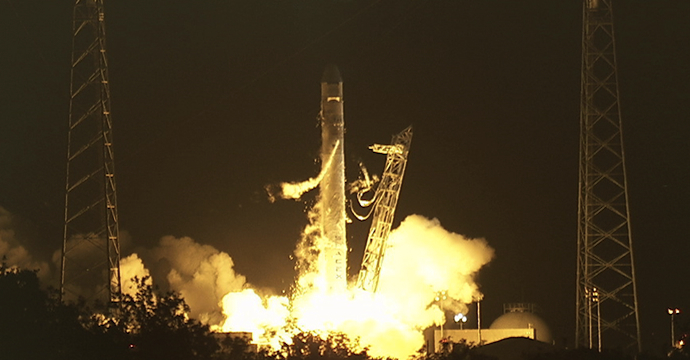Dreams of a new era of commercial space exploration took flight on early Tuesday morning as private company SpaceX successfully launched a rocket it hopes will become the first commercial vessel ever to dock with, and deliver cargo to, the International Space Station.
SpaceX’s Falcon 9 rocket blasted-off from Cape Canaveral at 3:44 am ET, exactly on time, following a “smooth countdown and no technical problems,” according to NASA, which is working with SpaceX on the mission.
The 157-foot-tall rocket reached Earth’s orbit about 10 minutes later and separated as planned from the Dragon cargo vessel aboard. The Dragon then deployed an array of solar panels that help to power the craft.
Watch the launch of the rocket in the following video from NASA:
“Falcon flew perfectly!! Dragon in orbit, comm locked and solar arrays active!! Feels like a giant weight just came off my back :),” tweeted Elon Musk, SpaceX’s CEO and chief designer, who founded the company with the billions he made after co-creating the online payments service PayPal.
Fielding questions in a video-conference from SpaceX’s headquarters in Hawthorne, California, Musk later compared the feeling he had in seeing the spacecraft take flight to “winning the Super Bowl.”
The early success this time stands in stark contrast to just three days prior, when SpaceX was forced to abort its launch of the Falcon 9 rocket just a half-second before takeoff, due to above-normal pressure readings in one of its nine engines caused by a faulty valve, which the company quickly replaced Saturday night. SpaceX has successfully launched the Falcon 9 twice before, in 2010 and 2011, and successfully test-flew the Dragon aboard the latter Falcon 9 flight.
The Dragon, now orbiting Earth, is the spacecraft that SpaceX will attempt to dock with the International Space Station later this week, on Friday, pending tests that will determine whether its sensors, controls and other equipment necessary to complete the historic docking procedure are in working order.
If this is completed, SpaceX will be allowed to dock with the station, becoming the first-ever nongovernmental entity to do so and the fifth ever, outside the United States, Russia, Japan and the European Union.
Then, on Saturday, astronauts currently aboard the space station will enter the attached Dragon capsule and transfer some 1,014 pounds of non-critical supplies, including food, water and clothing, from the Dragon to their orbital home. They’ll replace that cargo with another 1,367 pounds of discarded equipment and garbage and when the Dragon decouples from the station after about two weeks, it will take the new cargo back with it on its re-entry to Earth. The Dragon is supposed to plunge into the Pacific Ocean and be retrieved and re-used, becoming the first of a new class of reusable commercial cargo supply vessels made by SpaceX and other companies.
However, as both NASA and SpaceX officials cautioned, the docking is actually the most challenging part of the mission.
“There are still lots of activities that will occur over the next few days that will stretch the SpaceX team and even stretch the NASA team,” said William “Bill” Gerstenmaier, NASA’s associate administrator of human exploration operations, in the press conference held at NASA’s Kennedy Space Center in Florida following SpaceX’s launch on Tuesday.
Musk told reporters that the next great challenge SpaceX faced was opening the doors covering sensors that will guide the craft to, and facilitate docking with, the International Space Station.
“It’s a bit like a tiny version of ‘open the pod bay doors’ in 2001: A Space Odyssey,” Musk said, “We have a tiny pod bay door, and inside are the sensors that will lock onto the space station.”
Still, both NASA and SpaceX celebrated the launch as a milestone in the history of spaceflight and a key step in the longer-term plan to transition NASA’s space cargo transport needs, and eventually low-earth orbit crew transport needs, almost entirely over to private spacefaring companies.
“What this mission really does is it heralds the dawn of a new era of space exploration, where private spaceflight plays an increasingly critical role,” Musk said, “We’re at a similar inflection point for space as in the 1990s when the Internet was opened up to ordinary people. I hope and believe that this mission will be historic.”






